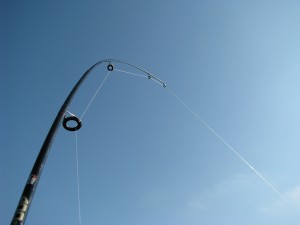 There are lots of lines on the market nowadays. Super line, flurocarbon, and monofilament being the most common. So which ones do you use?
There are lots of lines on the market nowadays. Super line, flurocarbon, and monofilament being the most common. So which ones do you use?
Super lines have many different features from monofilament. Super lines are very much thinner in diameter than mono lines. Super lines do not come in clear, usually only white, smoke or green. And they do not stretch under pressure. I would rather have a line that stretches so I can have some cushion when fighting fish. If there is no cushion you could possibly rip a large hole in the side of the fishes mouth while it ferociously tries to tear the hook out of its mouth.
And that just makes the odds better for the fish to shake the hook out. But having a no stretch line also has an upside. You can feel every little action which happens to the lure. When I fish for bass I believe mono lines have enough sensitivity to them.
Now for flurocarbon lines. I have never actually used this particular line but I have heard the following about them. Some manufacturers have not made good flurocarbon lines and I wish not to say which companies so I don’t get myself in trouble but I will say which ones have had good reviews on, “Seaguar” and “Stren”. They have a very high Strength/low diameter aspect to them which I really like especially for clear water. High durability meaning they do not rot. This adds to the life of the line but make sure you properly dispose of it because we do not need any of this stuff floating around our favourite fishing holes. And, most importantly, between the low diameter and material in which it is made out of fish cannot see it. It virtually disappears under water.
Now for the #1 most used line for largemouth bass, the good old monofilament. Many reasons make this line so popular, the many years it has been around for, it is inexpensive, and people have trusted it because of its so many years on the market compared to all the other lines. An advantage in my book is the stretching which cushions the thrash of a big bass. But there are disadvantages too. On disadvantage is that its strength is usually lowered due to knots. Many knots will cause the line to only have 75% of its initial strength. The best knot, though, is the Trilene Knot which holds, if tied properly, 90% of the lines initial strength. Also, mono lines do not last forever. Usually if you change your line once a year you will not have any problems. Mono line will actually rot after an amount of time. This may seem like a bad thing, but in actuality it is a very good thing. Old line DOES end up in the water. If this line didn’t rot away there would be tonnes of line getting wrapped up in motors and lying on the lake floor. One time when fishing I had my rod hanging over the side of the boat. Somehow my bail flipped open and I didn’t notice all my line fall into the water. I turned around looking for the line but it must of ended up on the bottom of the lake because I couldn’t find it. Luckily this line will eventually rot so there wont be my 120 yards of line on the bottom of this lake forever.
Since most people use mono here are some tips on how to keep your line fresh:
|
.If you follow these guidelines you will surely increase the chance of catching fish and decrease the chance of frustration.

Recent Comments